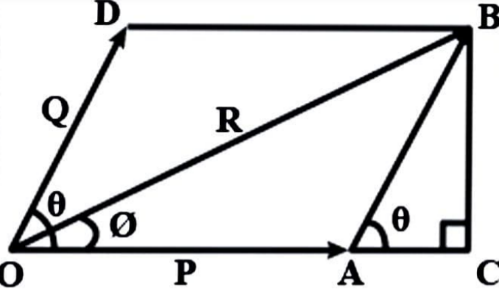
How do you find the angle of the resultant vector?
Answer
483.3k+ views
Hint: Let us first know about vectors. Vectors are useful in physics because they can represent location, displacement, velocity, and acceleration visually. When drawing vectors, you often don't have enough room to draw them to the scale they represent, therefore it's crucial to specify what scale you're working with.
Complete step by step solution:
Let P and Q be two vectors acting at the same time at a location, represented in magnitude and direction by two adjacent sides OA and OD of a parallelogram OABD, as shown in figure.
Let R be the resultant vector and be the angle between P and Q. The consequent of P and Q is therefore represented by diagonal OB, according to the parallelogram law of vector addition.

So,
$R = P + Q$
Expand A to C and draw BC perpendicular to OC at this point.
From triangle OCB
$O{B^2} = {C^2} + B{C^2}$
$ \Rightarrow $ $O{B^2} = {(OA + AC)^2} + B{C^2}$ ….$(1)$
In triangle ABC
$\cos \theta = \dfrac{{AC}}{{AB}}$
$ \Rightarrow $$AC = AB\,\cos \theta $
$ \Rightarrow $$AC = OD\,\cos \theta $
$AC = Q\cos \theta \,\,\,\,\,\,\,\,[AB = OD = Q]$
Also,
$\cos \theta = \dfrac{{BC}}{{AB}}$
$ \Rightarrow $\[\;BC{\text{ }} = {\text{ }}AB{\text{ }}sin\theta \]
$ \Rightarrow $\[BC{\text{ }} = {\text{ }}OD{\text{ }}sin\theta \]
$BC = Q{\text{ }}sin\theta \;{\text{ }}\;{\text{ }}\;{\text{ }}\;{\text{ }}\;{\text{ }}\;{\text{ }}\;{\text{ }}\;{\text{ }}\;{\text{ }}[{\text{ }}AB{\text{ }} = {\text{ }}OD{\text{ }} = {\text{ }}Q\;]$
Magnitude of resultant we will be:
Substituting value of AC and BC in $(1)$ we get
\[{R^2} = {(P + Qcos\theta )^2} + {(Qsin\theta )^2}\]
$ \Rightarrow $\[{R^2} = {P^2} + 2PQcos\theta + {Q^2}co{s^2}\theta + {Q^2}si{n^2}\theta \]
$ \Rightarrow $\[{R^2} = {P^2} + 2PQcos\theta + {Q^2}\]
$ \Rightarrow $\[R{\text{ }} = \;\sqrt {{P^2} + 2PQcos\theta + {Q^2}} \]
Now let us see the direction of Resultant:
Let $\phi $ be the angle made by the resultant R with P.
From triangle OBC,
\[tan\phi = \dfrac{{BC}}{{OC}} = \dfrac{{BC}}{{OA + AC}}\]
$ \Rightarrow $\[\;tan\phi = \dfrac{{Q\,\sin \theta }}{{P + Q\cos \theta }}\]
\[\phi = {\tan ^{ - 1}}\left( {\dfrac{{Q\sin \theta }}{{P + Q\cos \theta }}} \right)\]
This is the angle of the resultant vector.
Note:
We use vector values like displacement, acceleration, and force to launch satellites into the sky, target foes on the battlefield, do sophisticated calculations within computers, and even identify our location using GPS or a map. As a result, vectors play a crucial part in our lives.
Complete step by step solution:
Let P and Q be two vectors acting at the same time at a location, represented in magnitude and direction by two adjacent sides OA and OD of a parallelogram OABD, as shown in figure.
Let R be the resultant vector and be the angle between P and Q. The consequent of P and Q is therefore represented by diagonal OB, according to the parallelogram law of vector addition.

So,
$R = P + Q$
Expand A to C and draw BC perpendicular to OC at this point.
From triangle OCB
$O{B^2} = {C^2} + B{C^2}$
$ \Rightarrow $ $O{B^2} = {(OA + AC)^2} + B{C^2}$ ….$(1)$
In triangle ABC
$\cos \theta = \dfrac{{AC}}{{AB}}$
$ \Rightarrow $$AC = AB\,\cos \theta $
$ \Rightarrow $$AC = OD\,\cos \theta $
$AC = Q\cos \theta \,\,\,\,\,\,\,\,[AB = OD = Q]$
Also,
$\cos \theta = \dfrac{{BC}}{{AB}}$
$ \Rightarrow $\[\;BC{\text{ }} = {\text{ }}AB{\text{ }}sin\theta \]
$ \Rightarrow $\[BC{\text{ }} = {\text{ }}OD{\text{ }}sin\theta \]
$BC = Q{\text{ }}sin\theta \;{\text{ }}\;{\text{ }}\;{\text{ }}\;{\text{ }}\;{\text{ }}\;{\text{ }}\;{\text{ }}\;{\text{ }}\;{\text{ }}[{\text{ }}AB{\text{ }} = {\text{ }}OD{\text{ }} = {\text{ }}Q\;]$
Magnitude of resultant we will be:
Substituting value of AC and BC in $(1)$ we get
\[{R^2} = {(P + Qcos\theta )^2} + {(Qsin\theta )^2}\]
$ \Rightarrow $\[{R^2} = {P^2} + 2PQcos\theta + {Q^2}co{s^2}\theta + {Q^2}si{n^2}\theta \]
$ \Rightarrow $\[{R^2} = {P^2} + 2PQcos\theta + {Q^2}\]
$ \Rightarrow $\[R{\text{ }} = \;\sqrt {{P^2} + 2PQcos\theta + {Q^2}} \]
Now let us see the direction of Resultant:
Let $\phi $ be the angle made by the resultant R with P.
From triangle OBC,
\[tan\phi = \dfrac{{BC}}{{OC}} = \dfrac{{BC}}{{OA + AC}}\]
$ \Rightarrow $\[\;tan\phi = \dfrac{{Q\,\sin \theta }}{{P + Q\cos \theta }}\]
\[\phi = {\tan ^{ - 1}}\left( {\dfrac{{Q\sin \theta }}{{P + Q\cos \theta }}} \right)\]
This is the angle of the resultant vector.
Note:
We use vector values like displacement, acceleration, and force to launch satellites into the sky, target foes on the battlefield, do sophisticated calculations within computers, and even identify our location using GPS or a map. As a result, vectors play a crucial part in our lives.
Recently Updated Pages
Why are manures considered better than fertilizers class 11 biology CBSE

Find the coordinates of the midpoint of the line segment class 11 maths CBSE

Distinguish between static friction limiting friction class 11 physics CBSE

The Chairman of the constituent Assembly was A Jawaharlal class 11 social science CBSE

The first National Commission on Labour NCL submitted class 11 social science CBSE

Number of all subshell of n + l 7 is A 4 B 5 C 6 D class 11 chemistry CBSE

Trending doubts
What is meant by exothermic and endothermic reactions class 11 chemistry CBSE

10 examples of friction in our daily life

One Metric ton is equal to kg A 10000 B 1000 C 100 class 11 physics CBSE

1 Quintal is equal to a 110 kg b 10 kg c 100kg d 1000 class 11 physics CBSE

Difference Between Prokaryotic Cells and Eukaryotic Cells

What are Quantum numbers Explain the quantum number class 11 chemistry CBSE




